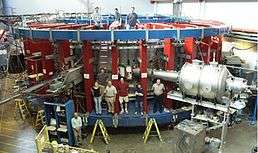Electric Tokamak

The UCLA Electric Tokamak is a low field (0.25 T) magnetic fusion tokamak device with a large aspect ratio. At present, ET is the largest tokamak ever built, with a vacuum vessel slightly bigger than JET.
The machine has a major radius of 5 metres, a minor radius of 1 metre, plasma current of 45 kiloamperes and can produce a core electron plasma temperature of 300 electronvolts.[1] [2] First plasma was achieved in January 1999.
Construction and features
Four sets of independent coils are necessary for OH (ohmic heating) current drive, vertical equilibrium field, plasma elongation and plasma shaping (D or reverse-D). The OH system provides 10 V·s using a 10 kA power supply. Up to 0.1 T of vertical field can be applied for horizontal control and this is more than sufficient for all plasma configurations, including high beta. An additional set of coils provide a small horizontal field to correct for error field and to stabilize the plasma vertically. All the coils are located outside the vessel and are constructed out of aluminium.
A Rogowski probe outside the vessel and sets of Hall probes inside the vessel are used to monitor plasma current, position and shaping and are used in the control feedback loop. The poloidal system was designed using an in-house equilibrium code as well as a variety of other codes in order to cross-check computations and to assess the stability of the resulting plasma.
Like most tokamaks the machine uses a combination of RF heating and neutral beam injection to drive and shape the plasma.
Financial status
The Electric Tokamak had run out of funding, and its principal investigator and designer, Robert Taylor, a UCLA professor, has retired. Factors leading to loss of funding are attributed to include its lack of extensive plasma diagnostics, its large size (it was the largest tokamak in the world[3]), and its place in the politics of fusion. When it was operating, The Electric Tokamak was funded mostly by the Department of Energy (DOE). It currently is being used for stress testing of plasma production methods in the Science and Technology Research Building (STRB) on the UCLA campus.
References
- ↑ http://www.iaea.org/programmes/ripc/physics/fec2000/pdf/exp1_07.pdf Initial Plasmas in the Electric Tokamak.
- ↑ http://adsabs.harvard.edu/abs/2001APS..DPPCP1012G Magnetic Activity and Stability of the UCLA Electric Tokamak. Nov 2001
- ↑ http://home.physics.ucla.edu/about/annualreport_0203.pdf
External links
- "Installation and Initial Testing of the Electric Tokamak Folded Waveguide" with photos.
- UCLA Electric Tokamak Homepage
- UCLA Tokamak Research